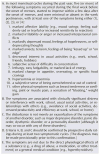Premenstrual dysphoric disorder: evidence for a new category for DSM-5
- PMID: 22764360
- PMCID: PMC3462360
- DOI: 10.1176/appi.ajp.2012.11081302
Premenstrual dysphoric disorder: evidence for a new category for DSM-5
Abstract
Premenstrual dysphoric disorder, which affects 2%–5% of premenopausal women, was included in Appendix B of DSMIV, "Criterion Sets and Axes Provided for Further Study." Since then, aided by the inclusion of specific and rigorous criteria in DSM-IV, there has been an explosion of research on the epidemiology, phenomenology, pathogenesis, and treatment of the disorder. In 2009, the Mood Disorders Work Group for DSM-5 convened a group of experts to examine the literature on premenstrual dysphoric disorder and provide recommendations regarding the appropriate criteria and placement for the disorder in DSM-5. Based on thorough review and lengthy discussion, the work group proposed that the information on the diagnosis, treatment, and validation of the disorder has matured sufficiently for it to qualify as a full category in DSM-5. A move to the position of category, rather than a criterion set in need of further study, will provide greater legitimacy for the disorder and encourage the growth of evidence-based research, ultimately leading to new treatments.
Figures


References
-
- Mason-Hohl E. The Diseases of Women, by Trotula of Salerno: A Translation of Passionibus Mulierum Curandorum by Elizabeth Mason-Hohl, MD. Los Angeles: Ward Ritchie Press; 1940.
-
- Frank RT. The hormonal causes of premenstrual tension. Arch Neurol Psychiatry. 1931;26:1053–1057.
-
- Endicott J. History, evolution, and diagnosis of premenstrual dysphoric disorder. J Clin Psychiatry. 2000;61(suppl 12):5–8. - PubMed
-
- American Psychiatric Association. Diagnostic and Statistical Manual of Mental Disorders. 3. Washington, DC: American Psychiatric Association; 1987. revised (DSM-III-R)
MeSH terms
Grants and funding
LinkOut - more resources
Full Text Sources
Other Literature Sources
Medical

